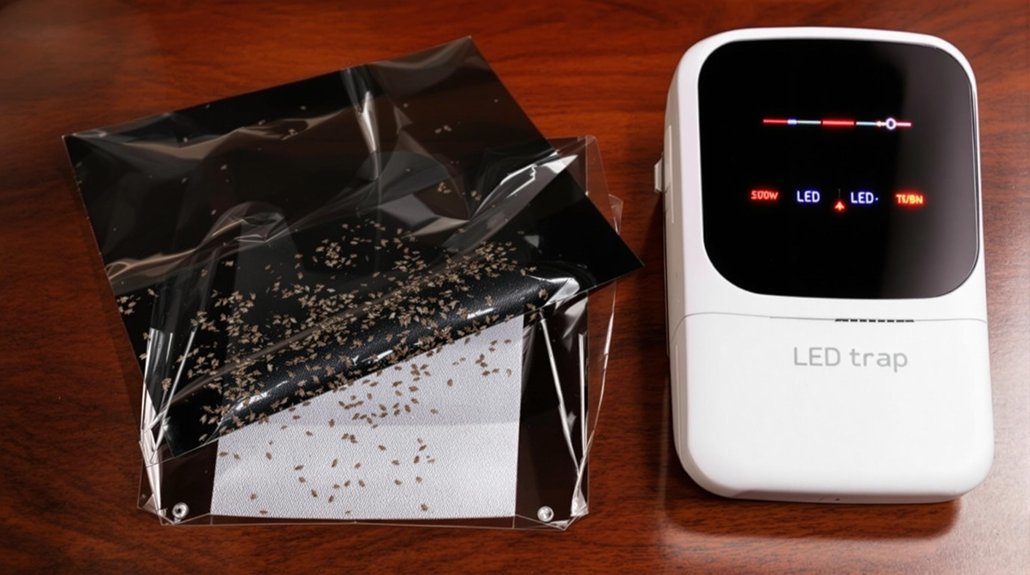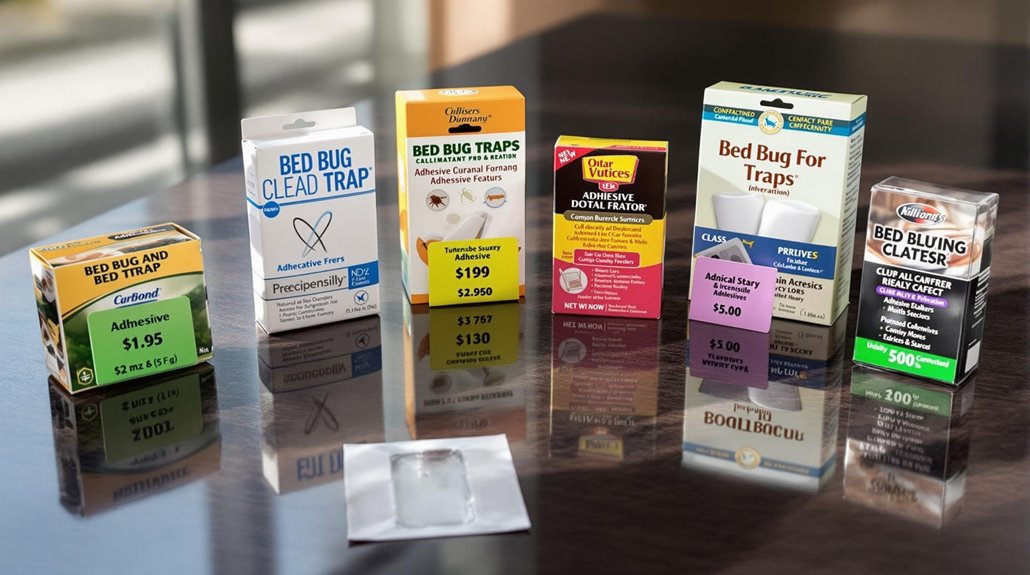The best bed bug trap effectively attracts and captures these pests, considering their nocturnal behavior and preference for human hosts. Chemical traps use scents, while electronic traps utilize heat or light. Sticky traps are simple but may miss some bugs. Ease of setup and clear instructions are important for effective usage. Costs range from disposable traps at $10 to professional ones over $50. Understanding these factors can help make a better choice for bed bug control. More insights await.
Key Article Highlights
- Trap Type Selection: Choose between chemical, electronic, or sticky traps based on your specific infestation needs and personal preferences.
- Effectiveness: Look for traps that utilize attractants like carbon dioxide or heat to enhance capture rates.
- Ease of Use: Opt for traps that are straightforward to set up and come with clear positioning instructions for optimal effectiveness.
- Cost Considerations: Compare disposable ($10-$15), reusable ($20-$30), and professional traps (starting at $50) to find the best value for your budget.
- User Reviews: Check customer feedback to gauge the performance and reliability of different traps in real-world scenarios.
Understanding Bed Bug Behavior
Many people may not realize that understanding bed bug behavior is essential for effective control. Bed bugs are small insects that thrive on human blood. Their habits include hiding in cracks and crevices during the day, making them difficult to spot. They are primarily nocturnal, meaning they come out at night to feed. This behavior can make it challenging for people to notice them until an infestation occurs. Knowing these patterns helps in taking action. Identifying where bed bugs hide and when they are most active is key to managing their presence. By learning about their habits, individuals can better prevent and eliminate bed bug issues, ultimately regaining their freedom from these unwanted pests.
Types of Bed Bug Traps
Understanding bed bug behavior lays the groundwork for effective trapping methods. There are several types of bed bug traps available, each designed to capture these pests in different ways. One common type is the chemical trap, which uses scents or insecticides to lure bed bugs in. These traps can be effective but may require careful handling due to the chemicals involved. Another option is electronic traps, which use light or heat to attract bed bugs. Once the bugs enter these traps, they are usually unable to escape. Each type of trap has its own advantages and disadvantages. Choosing the right one depends on personal preferences and the specific bed bug problem at hand.
Effectiveness of Various Traps

The effectiveness of various bed bug traps can vary considerably based on their design and functionality. Different trap designs serve unique purposes in pest control. For instance, some traps use attractants, such as carbon dioxide or heat, to lure bed bugs in. Others rely on sticky surfaces to capture them as they move. Each design has its strengths and weaknesses. Traps that mimic a host may be more effective in drawing bed bugs closer. However, sticky traps may not capture all bugs, especially if they avoid the area. Ultimately, the choice of trap can influence success in controlling bed bug populations. Understanding how these trap designs work helps individuals select the right method for effective pest control.
Ease of Use and Setup
Ease of use and setup are essential factors when selecting a bed bug trap. A trap should be easy to place and require minimal effort to set up. Most traps come with clear instructions, allowing users to quickly understand how to position them. Effective trap placement is vital; traps should be placed near areas where bed bugs are likely to travel, such as under the bed or alongside baseboards. User reviews often highlight the simplicity of setup as a major benefit, with many appreciating traps that do not require tools or complicated steps. A straightforward design can empower users, giving them confidence in their ability to combat bed bugs without feeling overwhelmed.
Cost Comparison and Value

When evaluating bed bug traps, cost comparison and value become important considerations. Different traps vary in price and materials, affecting both initial costs and long-term savings.
Here is a simple comparison:
| Trap Type | Cost | Main Materials |
|---|---|---|
| Disposable | $10-$15 | Cardboard, Glue |
| Reusable | $20-$30 | Plastic, Metal |
| Professional | $50+ | Advanced Materials |
Disposable traps are cheaper upfront but may need frequent replacement. Reusable traps have higher initial costs but can save money over time. Professional options often use advanced trap materials for better effectiveness. Ultimately, choosing the right trap involves balancing initial costs with potential long-term savings.
Frequently Asked Questions
Do Bed Bug Traps Attract Other Insects?
Research indicates that traps can capture up to 95% of bed bugs. However, bed bug behavior suggests some traps may inadvertently attract other insects, impacting their trap effectiveness and complicating pest control efforts.
How Long Do Bed Bug Traps Remain Effective?
Bed bug traps remain effective depending on their placement and the bed bug lifecycle. Typically, they function well for several weeks, but effectiveness can decline if not monitored and maintained regularly in targeted areas.
Are There Eco-Friendly Bed Bug Traps Available?
Eco-friendly options offer effective extermination without environmental harm. Traps made from eco-friendly materials utilize natural repellents to deter bed bugs. These sustainable solutions guarantee safety for families and the planet, promoting peaceful, pest-free living.
Can I Reuse Bed Bug Traps?
Bed bug traps can often be reused if they are properly maintained. Regular trap maintenance is essential for effective bed bug prevention, ensuring traps remain functional and continue to capture pests over time.
What Should I Do if Traps Do Not Work?
If traps do not work, one should consider trap alternatives like diatomaceous earth or essential oils. If problems persist, seeking professional extermination may be necessary to effectively eliminate the bed bug infestation and regain freedom.





